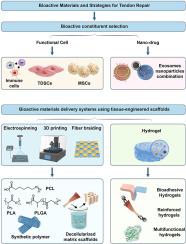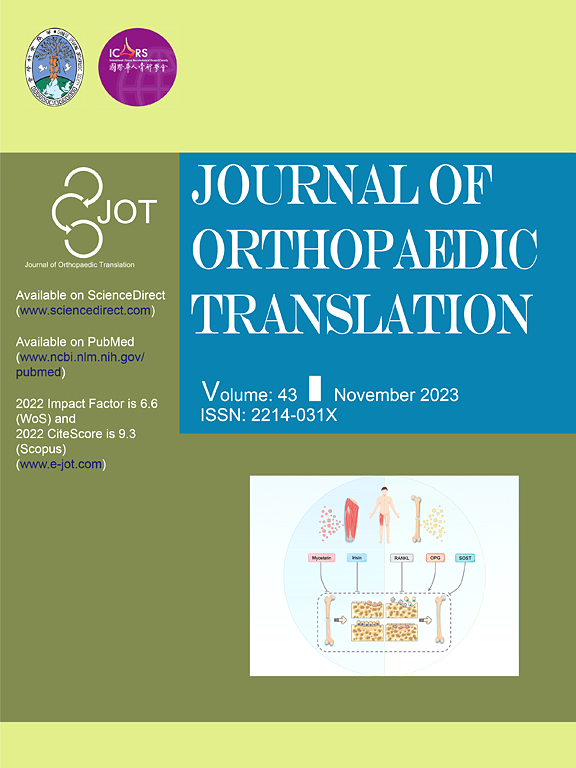用于肌腱修复和功能恢复的先进生物活性材料和策略
IF 5.9
1区 医学
Q1 ORTHOPEDICS
引用次数: 0
摘要
肌腱损伤是肌肉骨骼疾病中最常见的临床挑战之一。有效的肌腱修复对于恢复患者的运动功能和改善患者的生活质量至关重要。生物活性材料介导的肌腱再生的最新进展显示出巨大的治疗潜力和临床意义。然而,全面整合这些发展的系统综述仍然很少。本文首先介绍了生物活性成分的选择,主要包括基于细胞的治疗策略和纳米给药策略。其次,详细讨论了基于组织工程支架的生物活性材料递送系统。在本节中,我们通过不同的支架制备方法和合成原料来讨论支架在肌腱修复中的功效。此外,系统、全面地介绍了增强型水凝胶、生物黏附型水凝胶和多功能水凝胶等水凝胶体系在肌腱修复策略中的应用。最后,在详细回顾该领域的基础上,提出了该领域当前面临的挑战,并确定了该领域潜在的研究方向,包括智能生物活性材料的潜在研究方向和个性化治疗策略。本文综述了肌腱再生策略,从分子机制到组织水平的整合,包括生物活性成分的选择和使用组织工程支架的递送系统。它确定了转化障碍,并提出了针对肌腱特异性安全性验证、可扩展制造一致性和与传统疗法相比的成本效益的新策略。这些见解将完善肌腱损伤的临床策略,并推进靶向生物活性生物材料的局部再生。本文章由计算机程序翻译,如有差异,请以英文原文为准。

Advanced bioactive materials and strategies for tendon repair and function restoration
Tendon injury is one of the most common clinical challenges in musculoskeletal disorders. Effective tendon repair is crucial for restoring patients' motor function and improving their quality of life. Recent advances in bioactive material-mediated tendon regeneration have shown great therapeutic potential and clinical relevance. However, systematic reviews that comprehensively integrate these developments are still scarce. Firstly, this article presents the selection of bioactive components, mainly including cell-based therapeutic strategies and nanodrug delivery strategies. Secondly, bioactive materials delivery system using tissue-engineered scaffolds is discussed in detail. In this section, we discuss the efficacy of scaffolds in tendon repair through different scaffold preparation methods and synthetic raw materials. Furthermore, the application of hydrogel systems such as enhanced hydrogels, bioadhesive hydrogels and multifunctional hydrogels in tendon repair strategies is systematically and comprehensively presented. Finally, based on a detailed review of the field, current challenges in the field were proposed and potential research directions in the field were identified, including potential research directions in smart bioactive materials and personalized treatment strategies.
The translational potential of this article
This review synthesizes tendon regeneration strategies—from molecular mechanisms to tissue-level integration—including bioactive component selection and delivery systems using tissue-engineered scaffolds. It identifies translational barriers and proposes new strategies in tendon-specific safety validation, scalable manufacturing uniformity and cost-effectiveness versus conventional therapies. These insights will refine clinical strategies for tendon injuries and advance targeted bioactive biomaterials for localized regeneration.
求助全文
通过发布文献求助,成功后即可免费获取论文全文。
去求助
来源期刊

Journal of Orthopaedic Translation
Medicine-Orthopedics and Sports Medicine
CiteScore
11.80
自引率
13.60%
发文量
91
审稿时长
29 days
期刊介绍:
The Journal of Orthopaedic Translation (JOT) is the official peer-reviewed, open access journal of the Chinese Speaking Orthopaedic Society (CSOS) and the International Chinese Musculoskeletal Research Society (ICMRS). It is published quarterly, in January, April, July and October, by Elsevier.
 求助内容:
求助内容: 应助结果提醒方式:
应助结果提醒方式:


